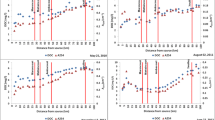Abstract
Compared with sporadic conventional water sampling, continuous water-quality monitoring with optical sensors has improved our understanding of freshwater dynamics. The basic principle in photometric measurements is the incident light at a given wavelength that is either reflected, scattered, or transmitted in the body of water. Here, we discuss the transmittance measurements. The amount of transmittance is inversely proportional to the concentration of the substance measured. However, the transmittance is subject to interference, because it can be affected by factors other than the substance targeted in the water. In this study, interference with the UV/Vis sensor nitrate plus nitrite measurements caused by organic carbon was evaluated. Total or dissolved organic carbon as well as nitrate plus nitrite concentrations were measured in various boreal waters with two UV/Vis sensors (5-mm and 35-mm pathlengths), using conventional laboratory analysis results as references. Organic carbon increased the sensor nitrate plus nitrite results, not only in waters with high organic carbon concentrations, but also at the lower concentrations (< 10 mg C L−1) typical of boreal stream, river, and lake waters. Our results demonstrated that local calibration with multiple linear regression, including both nitrate plus nitrite and dissolved organic carbon, can correct the error caused by organic carbon. However, high-frequency optical sensors continue to be excellent tools for environmental monitoring when they are properly calibrated for the local water matrix.







Similar content being viewed by others
References
Arvola, L., Einola, E., & Järvinen, M. (2015). Landscape properties and precipitation as determinants for high summer nitrogen load from boreal catchments. Landscape Ecology, 30, 429–442.
Caradot, N., Sonnenberg, H., Roualt, P., Gruber, G., Hofer, T., Torres, A., Pesci, M., & Bertrand-Krajewski, J.-L. (2015). Influence of local calibration on the quality of online wet weather discharge monitoring: Feedback from five international case studies. Water Science & Technology, 71(1), 45–51 IWA Publishing.
Drolc, A. & Vrtovšek, J. (2010). Case study: Nitrate and nitrite nitrogen determination in waste water using on-line UV spectrometric method. Bioresource Technology, 101, 4228–4233.
Erlandsson, M., Futter, M. N., Kothawala, D. N., & Köhler, S. J. (2012). Variability in spectral absorbance metrics across boreal lake waters. Journal of Environmental Monitoring, 14, 2643. doi:10.1039/c2em30266g.
Fowler, D., Coyle, M., Skiba, U., Sutton, M., Cape, N., Reis, S., Sheppard, L. J., Jenkins, A., Grizzetti, B., Galloway, J. N., Vitousek, P., Leach, A., Bouwman, A. F., Butterbach-Bahl, K., Dentener, F., Stevenson, D., Amann, M., & Voss, M. (2013). The global nitrogen cycle in the twenty-first century. Philosophical Transactions of the Royal Society B: Biological Sciences, 368, 20130164.
Galloway, J. N., Leach, A. M., Bleeker, A., & Erisman, J. W. (2013). A chronology of human understanding of the nitrogen cycle. Philosophical Transactions of the Royal Society B: Biological Sciences. doi:10.1098/rstb.2013.0120.
Gruber, N. & Galloway, J. N. (2008). An earth-system perspective of the global nitrogen cycle. Nature, 451, 293–296.
Huber, E. & Frost, M. (1998). Light scattering by small particles. Aqua, 47, 87–94. doi:10.1046/j.1365-2087.1998.00086.
Huotari, J. & Ketola, M. (2014). Jatkuvatoiminen levämäärien mittaus. Hyvät mittauskäytännöt ja aineiston käsittely. Ympäristöhallinnon ohjeita 5/2014.
Kortelainen, P. (1999). Occurrence of humic waters. Temporal and spatial variability. In J. Keskitalo & P. Eloranta (Eds.), Limnology of humic waters (pp. 46–55). Leiden: Backhuys Publishers.
Koskiaho, J., Lepistö, A., & Tattari, S. (2010). On-line measurements provide more accurate estimates of nutrient loading: A case of the Yläneenjoki river basin, southwest Finland. Water Science & Technology, 62(1), 115–122 IWA Publishing.
Lepot, M., Torres, A., Hofer, T., Caradot, N., Grubber, G., Aubin, J.-B., & Bertrand-Krajewski, J.-L. (2016). Calibration of UV/Vis spectrophotometers: A review and comparison of different methods to estimate TSS and total and dissolved COD concentrations in sewers, WWTPs and rivers. Water Research, 101, 519–534.
Linjama, J., Puustinen, M., Koskiaho, J., Tattari, S., Kotilainen, H., & Granlund, K. (2009). Implementation of automatic sensors for continuous monitoring of runoff quantity and quality in small catchments. Agricultural and Food Sciences, 18, 417–427.
Pellerin, B. A. & Bergamaschi, B. A. (2014). Optical sensors for water quality. Lakeline. Spring, 2014.
Pellerin, B.A., Bergamaschi, B.A., Downing, B.D., Saraceno, J., Garret, J.D., & Olsen, L.D. (2013). Optical techniques for the determination of nitrate in environmental waters: Guidelines for instrument selection, operation, deployment, maintenance, quality assurance, and data reporting. USGS Techniques and Methods Report, 1-D5. 37 pp.
Rockström, J., Steffen, W., Noone, K., Persson, A., Chapin III, F. S., Lambin, E., Lenton, T. M., Scheffer, M., Folke, C., Schellnhuber, H., Nykvist, B., De Wit, C. A., Hughes, T., van der Leeuw, S., Rodhe, H., Sorlin, S., Snyder, P. K., Costanza, R., Svedin, U., Falkenmark, M., Karlberg, L., Corell, R. W., Fabry, V. J., Hansen, J., Walker, B., Liverman, D., Richardson, K., Crutzen, P., & Foley, J. (2009). Planetary boundaries: Exploring the safe operating space for humanity. Ecology and Society, 14(2), 32. http://www.ecologyandsociety.org/vol14/iss2/art32/.
Van den Broeke, J., Langergraber, G. & Weingartner, A. (2006). On-line and in-situ UV/vis spectroscopy for multi-parameter measurements: A brief review. Spectroscopy Europe, 18, 1–4.
Acknowledgements
This study was funded by the M. and T. Nessling Foundation. We thank the laboratory staff of Lammi Biological Station for conducting the laboratory work. This study was conducted under projects: ERDF-funded New Solutions for Environmental Monitoring (YMLI A30175), Profitability and Added-Value for Agriculture from Automatic, Real-Time Monitoring of Environment and the Extension Services (EnviSense), Measurement, Monitoring and Environmental Assessment (MMEA), Processes Controlling DOC-Fluxes in Boreal Catchments (PRO-DOC), and N-Sink (LIFE12 ENV/FI/597).
Author information
Authors and Affiliations
Corresponding author
Rights and permissions
About this article
Cite this article
Uusheimo, S., Tulonen, T., Arvola, L. et al. Organic carbon causes interference with nitrate and nitrite measurements by UV/Vis spectrometers: the importance of local calibration. Environ Monit Assess 189, 357 (2017). https://doi.org/10.1007/s10661-017-6056-6
Received:
Accepted:
Published:
DOI: https://doi.org/10.1007/s10661-017-6056-6




